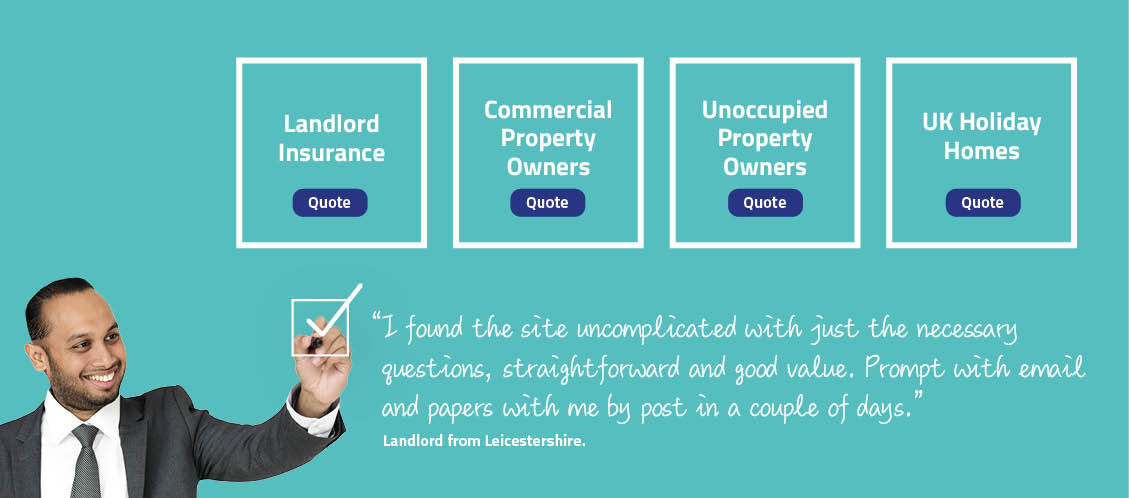As a landlord, you will be keen to protect the investment you have made in your buy to let property. Buy to let insurance (or landlords’ insurance as it is also known) will help you do just that. Choosing the appropriate policy is likely to involve you comparing landlords’ insurance to find the most suitable product for your property.
Here are some of the reasons for comparing landlords’ insurance and the factors you might want to consider when making those comparisons.
Make sure you have the appropriate cover
When arranging any kind of insurance, you want the most appropriate cover for the job. Before you can compare landlord insurance, though, you need to recognise many other types of property insurance that you might be offered.
From standard home insurance to commercial property insurance and from UK holiday let insurance to unoccupied property insurance, there is a bewildering array of different types to choose from – and landlord insurance simply adds to that long list.
Don’t be tempted to try and use a standard home buildings and contents insurance policy if you’re actually a landlord – it is a trap into which “accidental” landlords, in particular, might fall. Any owner-occupier insurance you have will typically become immediately invalid the moment you start obtaining rental income from your property – or even a part of it.
That may even apply if you rent it out infrequently for holiday use, Airbnb or even if you have a lodger – say through the government-backed Rent a Room scheme. If you’re obtaining rental income from a property, then you must have appropriate landlord’s cover.
Fit for purpose
Make sure that any landlord insurance you buy is fit for your particular, individual purposes.
Different landlords with different properties may all have their own set of requirements when it comes to their buy to let insurance cover. What is appropriate for one might be unsuitable for another.
Thankfully, therefore, there are a number of different types of policy with distinct levels of cover available all at a variety of different price levels. To be sure of getting the most appropriate for you, you need to conduct a landlord insurance comparison.
During that comparison, there’s nothing wrong with staying cost-conscious and trying to watch the pennies. But ensure you consider value for money rather than just price alone.
The differences between the policy terms and features of competitively priced policies might prove important and relevant to you and your buy to let business.
Making a judgement based on price alone may not give you the protection you need.
Categories of tenant
Landlords will have typically identified a particular target market from which to attract tenants for their let property.
Some types of accommodation may offer more flexibility in this respect than others and you may, therefore, need insurance protection that does not limit the types of tenant.
Not all policies offer cover for all types of tenant, with some specifically excluding certain categories – such as students, the unemployed, welfare benefits recipients or asylum-seekers.
Policies arranged by Cover4LetProperty offer you complete freedom in this respect and a policy that provides cover for all categories of tenant avoids your having to check your policy each time you re-let your property.
Inclusions and exclusions
Make sure to compare like with like when conducting your comparison of landlord insurance. A careful reading of the terms and conditions will prove a valuable way of identifying and understanding exactly what is included and what is excluded from the policies in which you might be interested.
Exclusions tell you what risks are not covered, of course, but there is a related consideration, often known as “warranties”, which may make one policy considerably less comprehensive than another.
An example might be the level of security needed to protect against theft loss or damage – if the warranted measures are not taken, the insurer may refuse to pay any associated claim.
You are also likely to encounter terms and conditions relating to unoccupied or empty property insurance. This may be required if your property is to stand empty for a period of 30-45 consecutive days or more. There may be several reasons for this, including building or refurbishment work, delays in tenants moving in, their absence on an extended holiday, and so on.
Features and options
Against all the background considerations we have considered so far, you will then need to move on to a comparison of the particular features and options presented by different landlords’ insurance policies.
The following are likely to be the most notable:
The bricks and mortar – building insurance
- at the heart of your landlord insurance is protection for the very structure and fabric of the building itself – building insurance;
- it provides for sufficient financial compensation for any repairs and reinstatement necessary after loss or damage to the building, including a worst-case scenario in which there is a total loss, and the land needs clearing, professional fees are required and the premises need to be rebuilt;
- typical risks covered in this central element of your policy are likely to include fire and smoke damage, flooding and storm damage, impacts (from vehicles and falling objects), vandalism, and theft;
- the total building sum insured must cover the estimated costs of that worst-case scenario in which the property must be completely rebuilt – an estimate on which you might want to consult professional valuers and surveyors or use the residential rebuilding cost calculator of The Building Cost Information Service (BCIS);
Protecting your contents
- if your property is let as furnished, the contents alone could be worth several thousand pounds or more;
- these – and any other contents you own in the let property – can be safeguarded by landlords contents insurance;
- whether you choose contents cover that replaces new for old or settles claims after the deduction of the estimated wear and tear of items will depend on the condition and value of your contents, of course – and we are more than happy to advise you accordingly;
- don’t give in to the temptation of understating the cost of your contents simply to try and keep your premiums lower, but conduct a room-by-room inventory to estimate your contents’ value accurately and avoid the risk of underinsurance;
Subsidence
- cover against the risk of subsidence is an issue with many property insurance policies – including the building element of your landlord insurance – since some policies include protection as standard, but by no means all do so;
- compare the landlord insurance policies arranged by us here at Cover4LetProperty and be reassured that all of them include cover against subsidence as standard.
Trace and access cover
If you have ever called in the tradesman to fix a fault only to be left facing the additional costs of having to make good damage that was caused by tracing and gaining access to the source of the problem, you might want to consider the benefits of optional trace and access cover to add to your landlord insurance policy.
Malicious damage by tenants
- however careful your tenancy selection and referencing safeguards, there remains a risk that rogue tenants cause malicious damage to your let property;
- by no means all buy to let insurance policies offer protection against such risks, so you might be reassured by the fact that all those arranged by us here at Cover4LetProperty include that cover as standard (up to pre-agreed limits);
- the cost of repairing any malicious damage caused by your tenants or their visitors might easily exceed the amount of any deposit you have taken- but note that even with this cover, there may be upper limits to how much the policy may pay out;
Landlords’ liability insurance
- compare landlord insurance quotes to verify that landlord’s liability indemnity insurance is included and to what level – different policies have different limits;
- the cover provides essential indemnity against claims made against you – as the landlord or property owner – by your tenants, their visitors, your neighbours or even members of the public who have suffered an injury or had their property damaged through some incident involving your let property;
- the possibility of serious injury or even death raises the prospect of very substantial claims for compensation, and for that reason, the minimum level of liability indemnity provided is at least £2 million – but frequently more;
Loss of rental income
- most landlord insurance policies incorporate some degree of compensation in the event of an insured incident causing such damage that the premises are no longer habitable until repairs or reinstatement has been made;
- clearly, this could result in your suffering considerable loss of rental income pending repairs and reinstatement of any damage;
- our policies offer provision for suitable compensation for such loss of rental income – subject to prescribed limits (typically reflecting a percentage of the total sum insured under your landlord insurance policy);
Excesses
- an excess is the first part of any claim for which you remain financially responsible – to this extent, an excess represents an uninsured loss;
- by accepting an additional voluntary excess, you may reduce the cost of your buy to let insurance premiums – this could be a way of securing discounts on some of our insurance policies;
- if you agree to accept a higher excess on your policy, of course, you may then need to make a more significant contribution towards the settlement of any claim.
Unoccupied property insurance
Typically, any insurer will consider your let property unoccupied once no one has been living there for a period of 30 to 45 consecutive days (the exact period may vary from one insurer to another).
And that may happen quickly if you’re between lets or just having your property converted or renovated.
If your landlord insurance policy becomes severely limited – or lapses altogether – once it is regarded as unoccupied, you will want to consider the protection of specialist unoccupied property insurance. Indeed, if you are buying the property with the help of a mortgage, your lender will probably insist on it.
Comparisons the easy way
It may be worth reiterating that in such a very crowded market, with so many different types of insurance, a variety of policies and competitive pricing from one insurer to another, it is often difficult to make accurate or meaningful comparisons.
At Cover4LetProperty, you might find the entire process of arranging your landlord insurance all the more straightforward by doing so entirely online.
Being able to arrange your landlord insurance online may make it easier than you think to arrange cover for your buy to let property. The days when you may have had to traipse up and down the high street if you were looking for cover are thankfully long gone.
Instead, you can now look at what providers are offering and compare landlord insurance online, using a service such as ours – and, hopefully, you’ll find a let insurance policy that matches your own unique needs and circumstances.
Alternatively, if you would prefer to speak to someone, then please call our friendly team on 01702 606 301 – they will be delighted to help!








